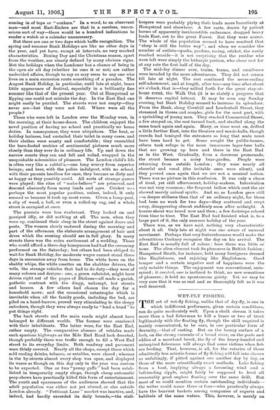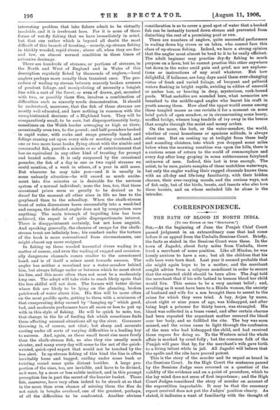WET-FLY FISHING.
THE art of wet-fly fishing, unlike that of dry-fly, is one in which indifferent performers, given certain conditions, can do quite moderately well. Upon a chalk stream it takes more than a bad fisherman to kill a brace or two of trout legitimately with the floating fly, though the skill required is mainly concentrated, to be sure, in one particular form of dexterity,—that of casting. But on the breezy surface of a loch, on the strong currents of a broad river, on the pools and eddies of a moorland brook, the fly of the heavy-handed and uninspired fisherman will always find some victims when fish are feeding. That, however, is all, for the votaries of these admittedly less artistic forms of fly-fishing will fall into classes as unfailingly, if pitted against one another day by day, as those of the more scientifically exact methods. Lake fishing from a boat, implying always a favouring wind and a befriending ripple, might fairly be supposed to level all reasonably good anglers floating over the same drift. But most of us could mention certain outstanding individuals— the writer could name three or four—who practically always have the heaviest baskets among companies of experts and habitues of the same waters. This, however, is merely an
interesting problem that lake fishers admit to be virtually insoluble, and it is irrelevant here. For it is none of these forms of wet-fly fishing that we have immediately in mind, but that one rather which is beyond all doubt the most difficult of this branch of trouting,—namely, up-stream fishing in thickly wooded, rapid rivers ; above all, when they are fine and low, an almost normal condition in these times of extensive drainage.
There are hundreds of streams, or portions of streams, in the North and West of England and in Wales of this description regularly fished by thousands of anglers,—local anglers perhaps more usually than transient ones. The pro- cedure of wading up stream between scarcely broken avenues of pendant foliage, and manipulating of necessity a longish line with a cast of the finest, or even of drawn, gut, mounted with two, or possibly three flies, involves a combination of difficulties such as scarcely needs demonstration. It should be understood, moreover, that the fish of these streams are mostly well educated, and have nothing in common with the unsophisticated denizens of a Highland burn. They will be comparatively small, to be sure, but disproportionately lusty, sometimes on the Welsh border averaging as high as three, occasionally even two, to the pound; and half-pounders hooked in rapid water, with rocks and snags generally handy and foliage craning out upon every aide or meeting overhead, and one or two more loose hooks .flying about with the nimble and resourceful fish, provide a minute or so of entertainment that has no equivalent in any other kind of trouting for prompt and heated action. It is only surpassed by the occasional pounder, the fish of a day in one or two rapid streams we could mention, of a week in others, of a year in still more. But wherever he may take you—and it is usually in some unhandy situation—he will crowd as much excite- ment into five minutes as is desirable for the nervous system of a normal individual; none the less, too, that these occasional prizes seem so greatly to be desired as to dwarf for the moment all other aims in life no less to the greybeard than to the schoolboy. When the chalk-stream trout of extra dimensions bores successfully into a weed-bed and escapes, the defeated angler does not by comparison care anything. The main triumph of beguiling him has been achieved, the sequel is of quite disproportionate interest. There is disappointment certainly, but not . keen anguish. And speaking generally, the chances of escape for the chalk- stream trout are infinitely less; his conduct under the torture of the hook is more conventional from circumstances, one might almost say more resigned.
In fishing up these wooded torrential rivers wading is a matter of course, and even the wading of rugged and occasion- ally dangerous channels comes readier to the accustomed band, and is of itself a minor asset towards success. The angler has neither a moorland nor a water-meadow behind him, but always foliage under or between which he must shoot his line, and this more often than not must be a moderately long one. The adept will take risks to reach likely spots that the less skilful will not dare. The former will better divine where fish are likely to be lying on the glancing, broken patchwork of water above him. His flies will be more often on the most prolific spots, getting to them with a minimum of that exasperating delay caused by "hanging up" which good, bad, and moderate performers have all more or less to put up with in this style of fishing. He will be quick to note, too, that change in the lie of feeding fish which sometimes finds them affecting unusual situations all up the river. Gossamer throwing is, of course, not vital; but sharp and accurate casting under all sorts of varying difficulties is a leading key to success. And, again, as these small trout rise more freely than the chalk-stream fish, so also they rise usually much shorter, and many every day will come to the net of the quick- wristed, quick-eyed expert that would not be touched by the less alert. In up-stream fishing of this kind the line is often inevitably loose and bagged, curling under some bush or twisting round some quite distant boulder. A large pro- portion of the rises, too, are invisible, and have to be divined, as it were, by a more or less subtle instinct, and in this prompt perception lies in part the secret of the heavier basket. These fish, moreover, have very often indeed to be struck at so that in the more than even chance of missing them the flies do not catch in boughs overhead, one of the greatest, perhaps, of all the difficulties to be confronted. Another obvious consideration is so to cover a good spot of water that a hooked fish can be instantly turned down stream and prevented from disturbing the rest of a promising pool or run.
There are numbers of anglers, quite successful performers in wading down big rivers or on lakes, who cannot face this class of up-stream fishing. Indeed, we have a strong opinion that the angler must almost be bred to it to be really efficient. The adult beginner may practise dry-fly fishing to much purpose on a lawn, but he cannot practise this other anywhere but down in the water amid pain and grief, nor are explana- tions or instructions of any avail whatever. But how delightful, if toilsome, are long days amid these ever-changing vistas of fresh and varied foliage, of buoyant and pellucid waters flashing in bright rapids, swirling in eddies of emerald or amber hue, or heaving in deep, mysterious, rock-bound pools. What melodies are sounded here, what memories are breathed to the middle-aged angler who learnt his craft in youth among them. How aloof the upper world seems among these tangled mazes as one revisits it for a moment on some brief patch of open meadow, or in circumventing some hoary, muffled bridge, whence long tendrils of ivy sway in the breeze that soughs through the moist and mossy arches.
On the moor, the loch, or the water-meadow, the world, whether of rural homeliness or spacious solitude, is always about one. But on corSing up at twilight from these leafy and sounding cloisters, into which you dropped some miles below when the morning sunshine was upon the hills, there is a curious sense of return to the world of commonplace and every day after long groping in some subterranean fairyland unknown of men. Indeed, this last is true enough. The artist, to be sure, paints samples of these matchless waterways, but only the angler wading their rugged channels knows them with an all-day and life-long familiarity, with their hidden charms, their ever-varying moods, and the curious ways, not of fish only, but of the birds, beasts, and insects who also love these haunts, and on whose secluded life he alone is the intruder.



































 Previous page
Previous page